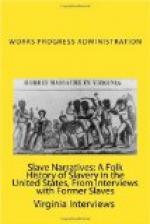Finally, I should like to recommend that the words darky and nigger and such expressions as “a comical little old black woman” be omitted from the editorial writing. Where the ex-slave himself uses these, they should be retained.
This material sent June 20 to states of: Ala., Ark., Fla., Ga., Ky., La., Md., Miss., Mo., N.C., Ohio, Okla., Tenn., Texas, Va., and S. Car.
[Document 8]
MEMORANDUM
July 30, 1937.
TO: STATE DIRECTORS OF THE FEDERAL WRITERS’
PROJECT
FROM: Henry G. Alsberg, Director
The following general suggestions are being sent to all the States where there are ex-slaves still living. They will not apply in toto to your State as they represent general conclusions reached after reading the mass of ex-slave material already submitted. However, they will, I hope, prove helpful as an indication, along broad lines, of what we want.
GENERAL SUGGESTIONS:
1. Instead of attempting to interview a large number of ex-slaves the workers should now concentrate on one or two of the more interesting and intelligent people, revisiting them, establishing friendly relations, and drawing them out over a period of time.
2. The specific questions suggested to be asked of the slaves should be only a basis, a beginning. The talk should run to all subjects, and the interviewer should take care to sieze upon the information already given, and stories already told, and from them derive other questions.
3. The interviewer should take the greatest care not to influence the point of view of the informant, and not to let his own opinion on the subject of slavery become obvious. Should the ex-slave, however, give only one side of the picture, the interviewer should suggest that there were other circumstances, and ask questions about them.
4. We suggest that each state choose one or two of their most successful ex-slave interviewers and have them take down some stories word for word. Some Negro informants are marvellous in their ability to participate in this type of interview. All stories should be as nearly word-for-word as is possible.
5. More emphasis should be laid on questions concerning the lives of the individuals since they were freed.
SUGGESTIONS TO INTERVIEWERS:
The interviewer should attempt to weave the following questions naturally into the conversation, in simple language. Many of the interviews show that the workers have simply sprung routine questions out of context, and received routine answers.
1. What did the ex-slaves expect from freedom? Forty acres and a mule? A distribution of the land of their masters’ plantation?
2. What did the slaves get after freedom? Were any of the plantations actually divided up? Did their masters give them any money? Were they under any compulsion after the war to remain as servants?




